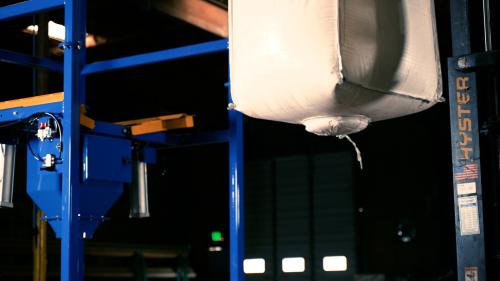Getting into a good flow means starting things off right. Bulk bag unloaders (aka bulk bag dischargers) are designed to extract dry bulk materials from an FIBC (flexible intermediate bulk container), thus beginning their processing journey. As with other key components of a dry bulk material handling system (such as bulk filling and bulk transfer equipment), pricing can range widely depending on the size and complexity of the setup.
In this guide, we'll talk through some of the standard configurations of Erie Technical Systems' bulk bag unloading equipment, how we can modify it to best suit your application, and what you can expect to budget for.
Anatomy of a Bulk Bag Unloader
Any bulk bag unloader includes at least these three key elements:
- A support frame: Primary support structure of the unloading system
- A lifting frame: Steadies and secures bulk bag for lifting and lowering
- Outlet support: Prevents discharge outlet from shifting (and consequent loss of product)
Other features may be integrated to assist with efficiency and safety of operation as needed, which will be largely dictated by throughput volumes and the materials that are being processed.
Among the most common are:
- Electric hoist and trolley: mount to a support beam to electronically assist with lifting of FIBCs
- Pinch rings and enclosed untie boxes: assist with containment of fine particulates
- Valves: Reseal bulk bag discharge outlet after partial emptying
- Flow aids: may include flexor paddles, flexible screw conveyors, fluidizing actuator pads, hydraulic rams, or rotary lump breakers to help push non-free-flowing materials through the system.
Questions You Should Ask Yourself Before Buying
How much height clearance do I need?
When it comes to setting up and swapping out FIBCs for unloading, height matters. You'll need to account for:
- The height of the bag itself: FIBCs typically have vertical dimensions that range from 40 all the way up to 75 inches.
- The clearance height required for discharge: Is there enough clearance between the discharge outlet and the bulk transfer equipment?
- Height of the ceiling: For units that include a hoist and trolley, the necessary support beam will add height. For units that are forklift supported, you'll need to factor in the height of the forklift mast.
How heavy are the bulk containers I am working with?
Heavier containers require a sturdier unloading station, and consequently thicker square steel tubes. Bulk bag unloaders are often built to accommodate 2000 lb. (3x3 tubes) or 4000 lb. bags (4"x4" tubes). If equipped with an electric hoist and trolley, the capacity of those components will weigh in on your decision as well.
What materials are being processed?
Free-flowing, non-hazardous dry bulk materials can be processed with fairly basic setups without much issue. However, materials that aerate, bridge, rathole, or pack will require the assistance of flow aides to keep things moving. Hazardous materials will necessitate additional safety or containment features; corrosive materials must be paired with 304 or 316 series steel that can withstand caustic conditions.
What is the most efficient operational setup for my application?
This is where we consider the volume of processing, amount of automation involved, and the overall layout of your facility and process. You'll need to consider measures pertaining to:
- Attaching the bulk bag to the lifting frame (via a forklift or a hoist).
- Untying the bag and starting the material flow
- Retying the bag (if not emptying all at once).
- Routing discharged materials to the next piece of equipment — via a straight or angled chute (downward movement), a vibratory conveyor (horizontal movement), or flexible screw conveyor/vibratory spiral elevator (upward movement).
- Protecting workers from injury and creating a safe and comfortable working environment.
We know we've unloaded a lot of details on you, but thankfully Erie Technical Systems keeps things simple with three starting points for building an optimized bulk bag discharge station.
UltiMAX [$12,000-$100,000]
What it is: The UltiMAX is Erie Technical Systems' premier dry bulk unloading solution, featuring heavy-duty construction (bearing loads of up to 5,000 pounds), modular frame sections to allow incorporation of hoists and discharge conveyors, a dust-tight bag untie box, and automatic and manual operation options.
Who it's right for: Full-scale dry bulk processors across a host of industries
Applications: With the necessary modifications, the UltiMAX can discharge virtually any dry bulk material. For stingier materials that solidify or clump up in the bag, we recommend investing in a bulk bag conditioner [$60,000]. Equipped with hydraulically-driven rams, bulk bag conditioners loosen up the material in an FIBC before loading into the UltiMAX.
Customizations: Hoist and trolley system [$8,000-$25,000], reclosable outlet spout valve [$3,000], corrosion-resistant stainless steel [$15,000], integrated flow aides [$2,000-$5,000]
Bulk Container Dumper [$25,000-$175,000]
What it is: Erie Technical Systems' bulk container dumpers are used to empty rigid dry bulk containers such as boxes, drums, and bins. These hydraulically-operated bulk container unloading systems are constructed from heavy-duty structural steel and available in two models — floor level or lift-and-dump (aka skip hoist).
Who it's right for: Generally manufacturers of coarser dry bulk materials (e.g., grains, nuts, construction aggregates, etc.)
Applications: Agricultural industry, food processing, mining and construction, and more
Customizations: Funnel lids (with or without valves) [$2,000+], discharge chutes [$2,000+], stainless steel construction [$5,000-$50,000], skip hoist (allows discharge height adjustment) [$10,000+], lift to seal design (for unsealing/resealing partially emptied containers) [$10,000+]
Bag Break Station [$40,000+]
What it is: A bulk bag unloading system for smaller bags weighing between 25 and 100 pounds. Standard units are equipped with fast-flow rounded hopper corners, a convenient working height, and collapsible sitting shelf for bag support.
Who it's right for: Processors who value convenience and a safe, clean working environment.
Applications: Any variety of materials at lower volumes, but its automated dust collection system makes it especially suited for dusty powders. It's self-cleaning as well (automatically triggered reverse-pulse filters)!
Customizations: Rotary lump breaker [$7,000+], bottom outlet rotary airlock valve [$10,000+], integral FlexMAX flexible screw conveyor [$10,000+], pneumatic fluidizing aeration pads [$1,000+], rotary electric bin activator [$400+]
Dry Bulk Unloading Solutions from Erie Technical Systems
Take a load off your operational demands with dry bulk unloading solutions from Erie Technical Systems. Our knowledgeable staff is ready to assist you with a standard or custom-built bulk bag unloader that suits your needs.

